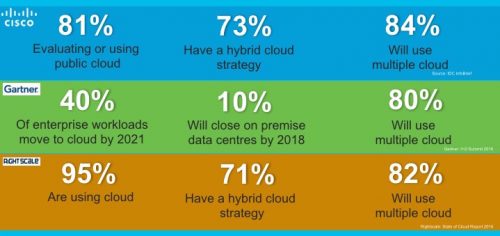
Hybrid is the new black if you want to embrace cloud native
Many of today’s most disruptive companies are building apps in the cloud to innovate and scale at speed. This cloud native model is one that banks, insurers, consumer goods firms and manufacturers are looking to follow.
According to a new study by Capgemini and Longitude Research, the adoption of cloud-native app development will jump from 15% currently to 32% by 2020 as companies aim to exploit capabilities such as:
- Microservices – breaking down code into modular units that can be scaled independently
- Containers – allowing units of code to be moved around easily without risk to the environment
- DevOps – the culture and process of continuous delivery that organisations use to implement microservices
In the past, IT teams developed apps with discrete design, build and run phases lasting a few months or more. Building apps directly in the cloud using microservices means development is continuous and cycle times are much shorter.
Typically built and run using Platform-as-a-Service (PaaS), a key principle of microservices is that they operate independently of each other. One service can be designed, tested, deployed, or replaced without impacting the others.
Capgemini’s study asked 900 executives how a cloud-native approach was driving change at their organisations. It found they expect IT to become even more central to supporting business aims including:
- Development of new business models (67%)
- Rapid scaling of the business (72%)
- Quicker updating of products/services (71%)
- Adopting new routes to market (68%)
The study depicts a world of cloud-native leaders and laggards. One in which leaders are building more than 20% of their apps in the cloud, and where laggards risk falling ‘dangerously behind’. The main hurdle cited by CIOs and IT managers was integrating cloud-native apps with legacy infrastructure.
Hybrid the new black
With cloud-native and digital savvy businesses proving faster, more agile and more able to deliver a superior customer experience, the pressure is to move to the cloud. But while modern apps need modern IT, this cannot just mean ‘stick it in the cloud’. Not all apps and workloads are suitable. Not all can be migrated. Legacy apps and those deployed in hybrid and public cloud must all exist in tandem.
A recent survey of 302 top IT executives by Forbes Insights in partnership with Cisco found that 77% said their organisation employs a hybrid cloud model. Almost two-thirds regard it as very important to have a hybrid cloud strategy that combines both private and public cloud services. These findings are supported by research from multiple sources [see figure below].
The survey also highlights that workloads are being moved to, from and between clouds. For example, two thirds of enterprises (65%) had discontinued or scaled back the use of a public cloud service within the past two years, looking to relocate to other clouds or re-patriate apps to the private cloud. Drivers for this can include data gravity, cost and compliance.

Transform with ASAP
Private clouds and data centres are therefore key elements in this multi-cloud world. Having the right app in the right location, at the right time will be vital to gaining market advantage in the digital economy.
Whether it’s a traditional app, re-architected cloud app or cloud native app, you need a technology platform that enables application portability for any eventuality across a multi-cloud world.
This is the rationale behind Cisco’s ASAP data centre architecture. Conceived for a world of apps always in development, ASAP empowers users with the flexibility to run any traditional or cloud native app across any environment: on-premises, managed, or public cloud.
For example, Docker Enterprise Edition integrated into Cisco compute allows developers and IT operations to collaborate. It brings security, policy and controls to the app lifecycle without sacrificing agility or app portability.
We’ve also addressed the challenges around container networking by making it easier to deploy microservices within your environment via an open source solution that replaces and adds to the Docker and Kubernetes default one, Contiv. In addition, we’ve introduced a Kubernetes plug in for our software defined networking solution ACI. The latter is specifically for Kubernetes use, while Contiv is for container networking plus other use cases.
Ultimately, our aim is to give you the freedom to choose the best models for your business. Whether it’s an easy way to deploy and manage your apps onto any cloud or data centre, or consuming the software and services you need on your terms, our solutions allow you to progress in simple, practical and affordable steps. All with seamless integration across the IT stack and open partner ecosystem.
Take a look at our new interactive eBook to learn more about modernising your infrastructure, embracing cloud-native and hybrid IT.
Tags:



